Ecological Risk Assessment of Saltwater Intrusion and Urban Ecosystem Management in Shenzhen City
Abstract
:1. Introduction
2. Methodology and Methods
2.1. Study Area
2.2. Processing Data Related to ERA
2.3. Concept Framework of Ecology Risk Assessment
2.4. Analysis of the Geographical Mechanism of SWI
2.5. Mapping the SWI-Affected Zone
2.6. Exploring the Freshwater-Remediation Capacity from Mountain Phreatic Water
2.7. Rating the Salt Tolerance of Groundcover Plants
2.8. Estimating the Emergency-Response Capacity
2.9. Building the Comprehensive Evaluation Ecological Risk Model of SWI
3. Results
3.1. Results of ERA from SWI
3.2. Characteristics of the SWI-Affected Zone
3.3. Difference between the Four Factors of SWI
3.4. Evaluation Result of the Urban Greenbelt Regarding the Ecological Risk for SWI
4. Discussion
4.1. Enhancing Freshwater Ecosystem Services
4.2. Planting the Salt-Tolerant Vegetation Type
4.3. Limiting High-Position Saltwater Aquaculture
4.4. Policy Implications for Garden Cities
5. Conclusions
Supplementary Materials
Author Contributions
Funding
Data Availability Statement
Acknowledgments
Conflicts of Interest
References
- Eamus, D.; Fu, B.; Springer, A.E.; Stevens, L.E. Groundwater Dependent Ecosystems: Classification, Identification Techniques and Threats. In Integrated Groundwater Management; Jakeman, A.J., Barreteau, O., Hunt, R.J., Rinaudo, J.-D., Ross, A., Eds.; Springer International Publishing: Cham, Switzerland, 2016; pp. 313–346. ISBN 978-3-319-23575-2. [Google Scholar]
- Mondal, P.; Walter, M.; Miller, J.; Epanchin-Niell, R.; Gedan, K.; Yawatkar, V.; Nguyen, E.; Tully, K.L. The Spread and Cost of Saltwater Intrusion in the US Mid-Atlantic. Nat. Sustain. 2023, 6, 1352–1362. [Google Scholar] [CrossRef]
- Tully, K.; Gedan, K.; Epanchin-Niell, R.; Strong, A.; Bernhardt, E.S.; BenDor, T.; Mitchell, M.; Kominoski, J.; Jordan, T.E.; Neubauer, S.C.; et al. The Invisible Flood: The Chemistry, Ecology, and Social Implications of Coastal Saltwater Intrusion. BioScience 2019, 69, 368–378. [Google Scholar] [CrossRef]
- Wang, H.; Li, W.; Xiang, W. Sea Level Rise along China Coast in the Last 60 Years. Acta Oceanol. Sin. 2022, 41, 18–26. [Google Scholar] [CrossRef]
- Qian, Y.; Dong, Z.; Yan, Y.; Tang, L. Ecological Risk Assessment Models for Simulating Impacts of Land Use and Landscape Pattern on Ecosystem Services. Sci. Total Environ. 2022, 833, 155218. [Google Scholar] [CrossRef] [PubMed]
- Kang, P.; Chen, W.; Hou, Y.; Li, Y. Linking Ecosystem Services and Ecosystem Health to Ecological Risk Assessment: A Case Study of the Beijing-Tianjin-Hebei Urban Agglomeration. Sci. Total Environ. 2018, 636, 1442–1454. [Google Scholar] [CrossRef]
- Chen, J.; Mueller, V.; Durand, F.; Lisco, E.; Zhong, Q.; Sherin, V.R.; Saiful Islam, A.K.M. Salinization of the Bangladesh Delta Worsens Economic Precarity. Popul. Environ. 2022, 44, 226–247. [Google Scholar] [CrossRef]
- Cao, T.; Han, D.; Song, X. Past, Present, and Future of Global Seawater Intrusion Research: A Bibliometric Analysis. J. Hydrol. 2021, 603, 126844. [Google Scholar] [CrossRef]
- Fu, T.; Fu, Y.; Li, C.; Dong, M.; Qi, C.; Wang, Z.; Chen, G.; Su, Q.; Xu, X.; Yu, H. Seawater Intrusion-Triggered High Fluoride Groundwater Development on the Eastern Coast of China. Environ. Sci. Pollut. Res. 2024, 31, 11307–11320. [Google Scholar] [CrossRef] [PubMed]
- Yu, Y.; Zhi, J.; Wei, B.; Cheng, J.; Hu, L.; Lu, W.; Gong, S. Seawater Intrusion on the West Coast of Shenzhen during 1980–2020 Due to the Influence of Anthropogenic Activities. Env. Monit. Assess 2023, 195, 545. [Google Scholar] [CrossRef]
- Luijendijk, E.; Gleeson, T.; Moosdorf, N. Fresh Groundwater Discharge Insignificant for the World’s Oceans but Important for Coastal Ecosystems. Nat. Commun. 2020, 11, 1260. [Google Scholar] [CrossRef]
- Zhou, W.; Wang, D.; Luo, L. Investigation of Saltwater Intrusion and Salinity Stratification in Winter of 2007/2008 in the Zhujiang River Estuary in China. Acta Oceanol. Sin. 2012, 31, 31–46. [Google Scholar] [CrossRef]
- Tang, L.; Wang, L.; Li, Q.; Zhao, J. A Framework Designation for the Assessment of Urban Ecological Risks. Int. J. Sustain. Dev. World Ecol. 2018, 25, 387–395. [Google Scholar] [CrossRef]
- Hua, L.; Shao, G.; Zhao, J. A Concise Review of Ecological Risk Assessment for Urban Ecosystem Application Associated with Rapid Urbanization Processes. Int. J. Sustain. Dev. World Ecol. 2017, 24, 248–261. [Google Scholar] [CrossRef]
- Liu, M.; Chen, L.; Gou, Y.; Dong, R. Assessment of Urban Ecological Risk from Spatial Interaction Models for Lijiang City. Int. J. Sustain. Dev. World Ecol. 2011, 18, 537–542. [Google Scholar] [CrossRef]
- Jasechko, S.; Perrone, D.; Seybold, H.; Fan, Y.; Kirchner, J.W. Groundwater Level Observations in 250,000 Coastal US Wells Reveal Scope of Potential Seawater Intrusion. Nat. Commun. 2020, 11, 3229. [Google Scholar] [CrossRef]
- Hong, W.; Guo, R.; Tang, H. Potential Assessment and Implementation Strategy for Roof Greening in Highly Urbanized Areas: A Case Study in Shenzhen, China. Cities 2019, 95, 102468. [Google Scholar] [CrossRef]
- Chen, K.; Jiao, J.J. Preliminary Study on Seawater Intrusion and Aquifer Freshening near Reclaimed Coastal Area of Shenzhen, China. Water Sci. Technol. Water Supply 2007, 7, 137–145. [Google Scholar] [CrossRef]
- Zhanwen, Q.; Islam, M.Z. Urban Equilibrium: Legal Imperatives for Sustainable Development and Habitat Preservation in Shenzhen, China. Urban. Ecosyst. 2024; Early access. [Google Scholar] [CrossRef]
- Research Institute for Eco-Civilization, CASS; UNDP. Shenzhen Sustainable Development Report 2021. 2021. Available online: https://www.undp.org/zh/china/publications/shenzhenkechixufazhanbaogao2021nian (accessed on 11 August 2024).
- Norton, S.B.; Rodier, D.J.; Van Der Schalie, W.H.; Wood, W.P.; Slimak, M.W.; Gentile, J.H. A Framework for Ecological Risk Assessment at the EPA. Enviro Toxic. Chem. 1992, 11, 1663–1672. [Google Scholar] [CrossRef]
- Liu, X.; Hu, R.; Huang, Y. Screening and application of waterfront salt-tolerant plants in Qianhai Cooperation Zone. China Rural. Water Hydropower 2017, 1, 66–68. [Google Scholar]
- Zou, C.; Dai, Y.; Shi, Z.; Xu, J. Application Survey and Salty Damage Analysis to Coastal Landscape Plants of Shenzhen City. Landsc. Plant Study Appl. 2013, 35, 62–68. [Google Scholar]
- Deng, Y.; Young, C.; Fu, X.; Song, J.; Peng, Z.-R. The Integrated Impacts of Human Activities and Rising Sea Level on the Saltwater Intrusion in the East Coast of the Yucatan Peninsula, Mexico. Nat. Hazards 2017, 85, 1063–1088. [Google Scholar] [CrossRef]
- Giordana, G.; Montginoul, M. Policy instruments to fight against seawater intrusion in coastal aquifers: An overview. Vie Milieu 2006, 56, 287–294. [Google Scholar]
- Han, D.; Post, V.E.A.; Song, X. Groundwater Salinization Processes and Reversibility of Seawater Intrusion in Coastal Carbonate Aquifers. J. Hydrol. 2015, 531, 1067–1080. [Google Scholar] [CrossRef]
- Middleton, B.A.; Boudell, J. Salinification of Coastal Wetlands and Freshwater Management to Support Resilience. Ecosyst. Health Sustain. 2023, 9, 0083. [Google Scholar] [CrossRef]
- Zhi, X.; Yang, X.; Ren, J.; Wu, H.; Zhu, J.; Zhang, H. Research Progress in Salt Tolerance Evaluation and Identification of Garden Plants in China. World For. Res. 2018, 31, 51–57. [Google Scholar] [CrossRef]
- Dong, R.; Zhang, X.; Li, H. Constructing the Ecological Security Pattern for Sponge City: A Case Study in Zhengzhou, China. Water 2019, 11, 284. [Google Scholar] [CrossRef]
- Dong, R.; Liu, X.; Liu, M.; Feng, Q.; Su, X.; Wu, G. Landsenses Ecological Planning for the Xianghe Segment of China’s Grand Canal. Int. J. Sustain. Dev. World Ecol. 2016, 23, 298–304. [Google Scholar] [CrossRef]
- Ngo, M.T.; Lee, J.M.; Lee, H.A.; Woo, N.C. The Sustainability Risk of Ho Chi Minh City, Vietnam, Due to Saltwater Intrusion. Geosci. J. 2015, 19, 547–560. [Google Scholar] [CrossRef]
- Akbaba, M.; Özden, E. Salt Tolerance of Endophytic Root Bacteria and Their Effects on Seed Germination and Viability on Tomato Plants. Braz. J. Microbiol. 2023, 54, 3147–3162. [Google Scholar] [CrossRef]
- Magnan, A.K.; Oppenheimer, M.; Garschagen, M.; Buchanan, M.K.; Duvat, V.K.E.; Forbes, D.L.; Ford, J.D.; Lambert, E.; Petzold, J.; Renaud, F.G.; et al. Sea Level Rise Risks and Societal Adaptation Benefits in Low-Lying Coastal Areas. Sci. Rep. 2022, 12, 10677. [Google Scholar] [CrossRef]
- Tang, Z.; Liu, X.; Niu, X.; Yin, H.; Liu, M.; Zhang, D.; Guo, H. Ecological Risk Assessment of Aquatic Organisms Induced by Heavy Metals in the Estuarine Waters of the Pearl River. Sci. Rep. 2023, 13, 9145. [Google Scholar] [CrossRef] [PubMed]
- Kumar, C.; Verma, S.B.; Singh, A.K. Sustainable Management of Soil Salinity with Special Reference to Smart Fertigation Systems. Proc. Natl. Acad. Sci. India Sect. B Biol. Sci. 2023. [Google Scholar] [CrossRef]
- Lee, J.; Biemond, B.; De Swart, H.; Dijkstra, H.A. Increasing Risks of Extreme Salt Intrusion Events across European Estuaries in a Warming Climate. Commun. Earth Environ. 2024, 5, 60. [Google Scholar] [CrossRef]
- Huang, F.; Wang, G.H.; Yang, Y.Y.; Wang, C.B. Overexploitation Status of Groundwater and Induced Geological Hazards in China. Nat. Hazards 2014, 73, 727–741. [Google Scholar] [CrossRef]
- Senthilkumar, S.; Vinodh, K.; Johnson Babu, G.; Gowtham, B.; Arulprakasam, V. Integrated Seawater Intrusion Study of Coastal Region of Thiruvallur District, Tamil Nadu, South India. Appl. Water Sci. 2019, 9, 124. [Google Scholar] [CrossRef]

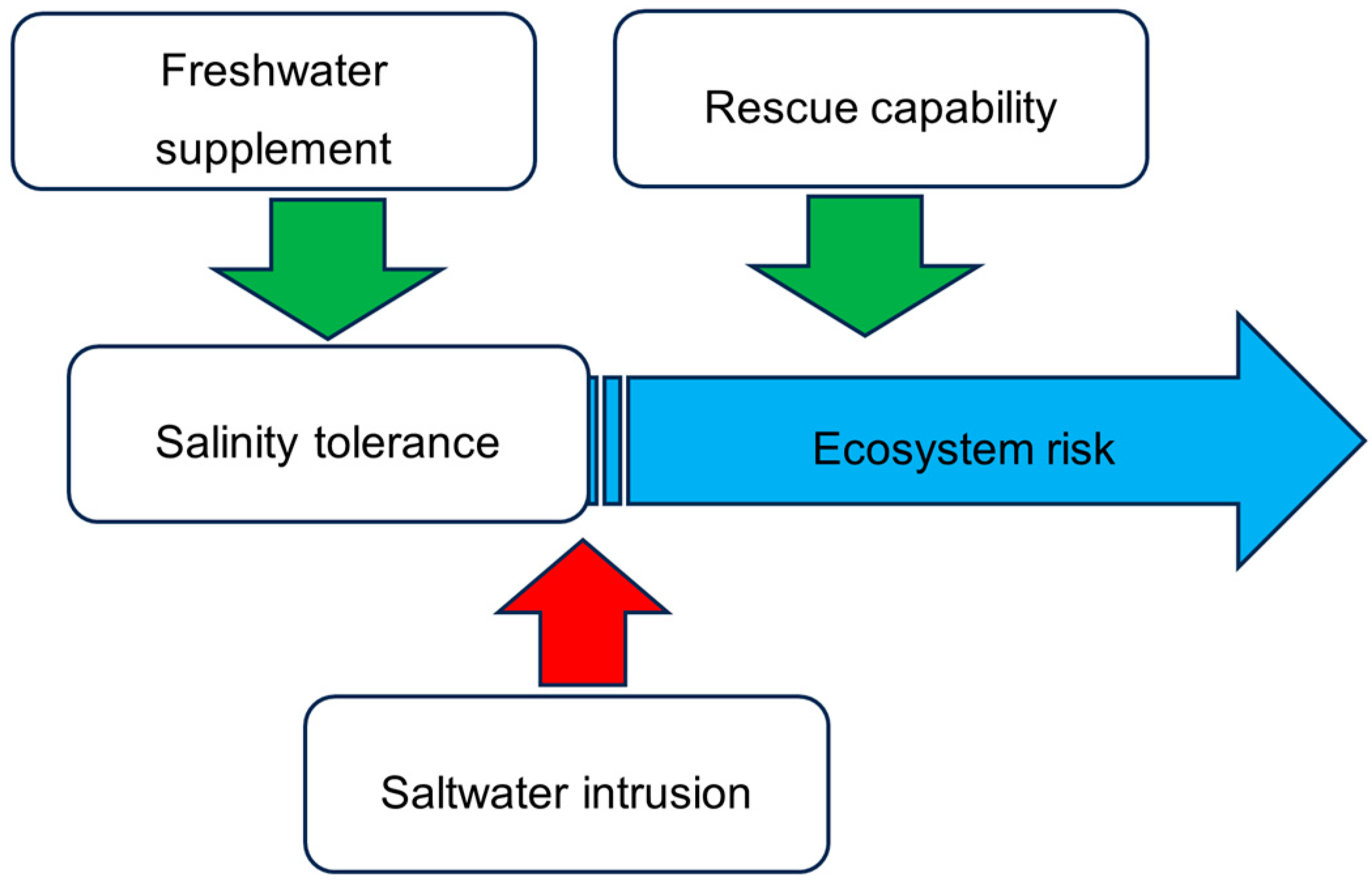
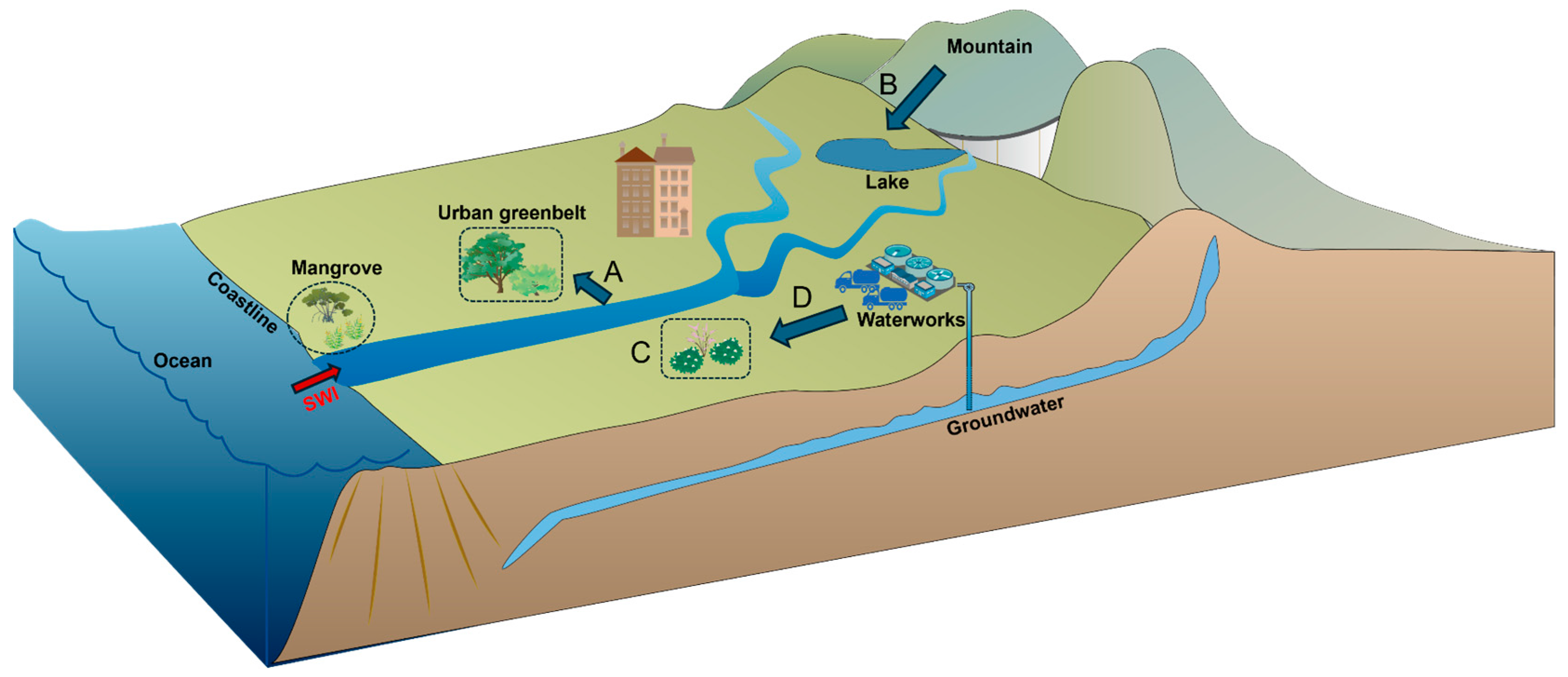
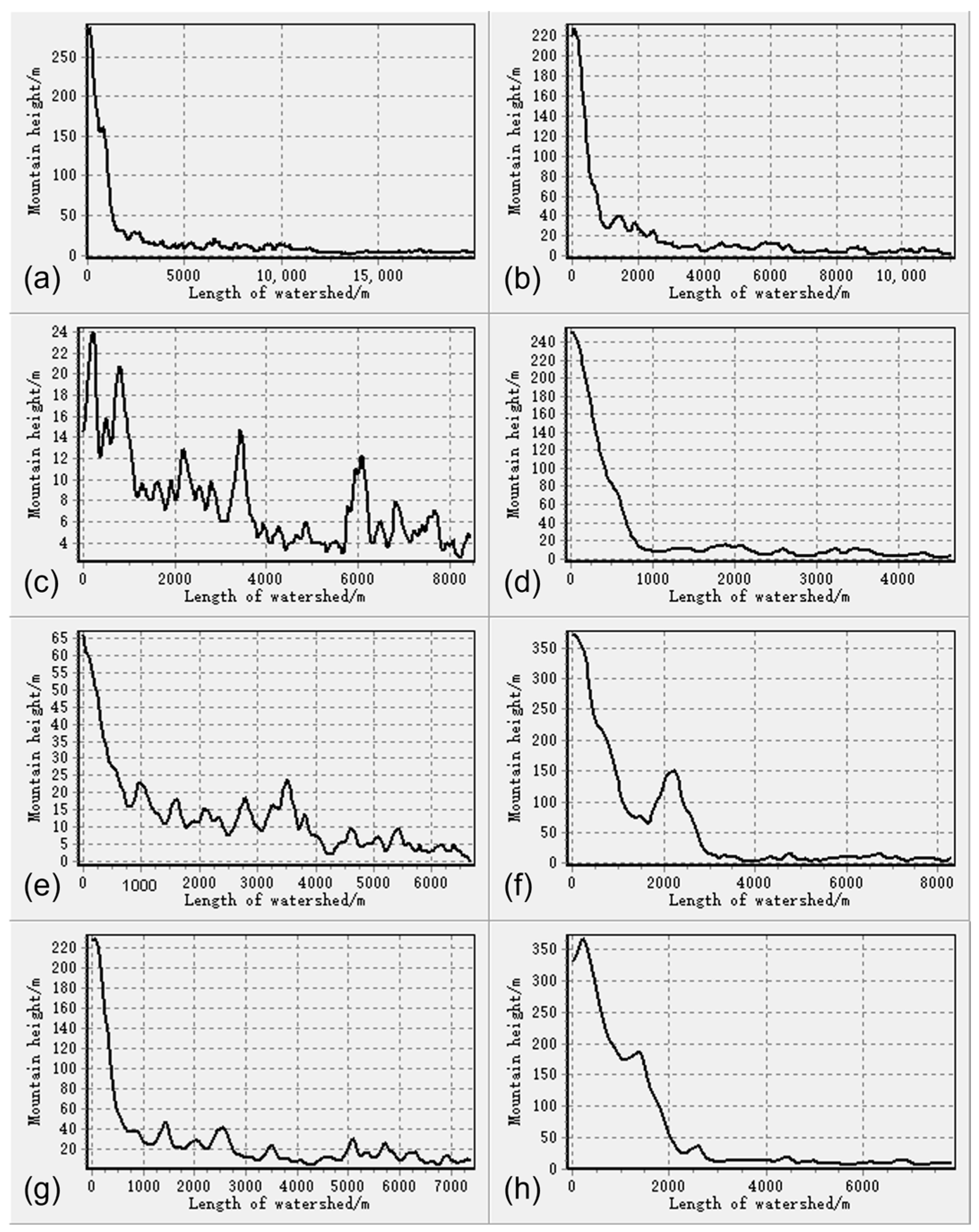
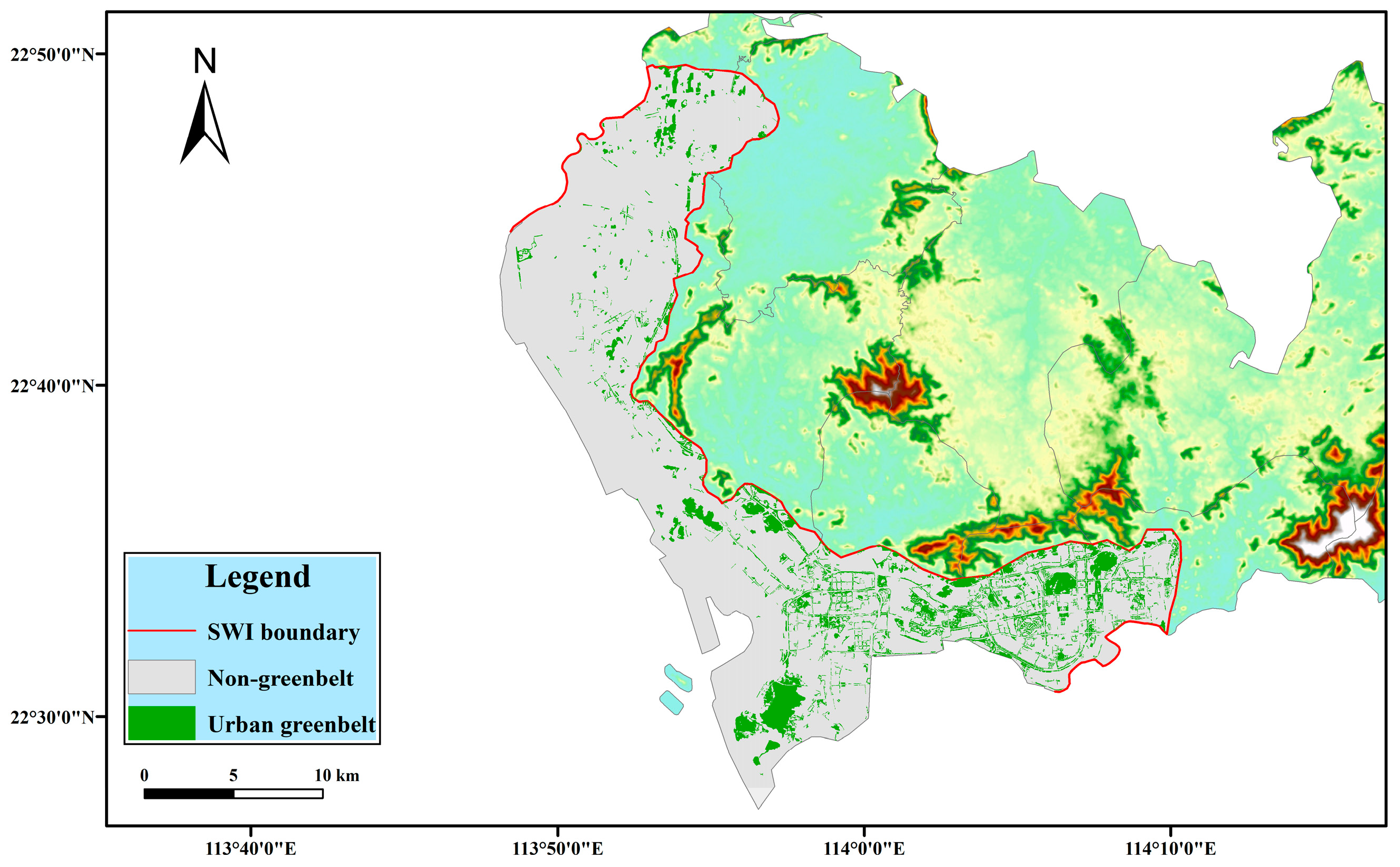
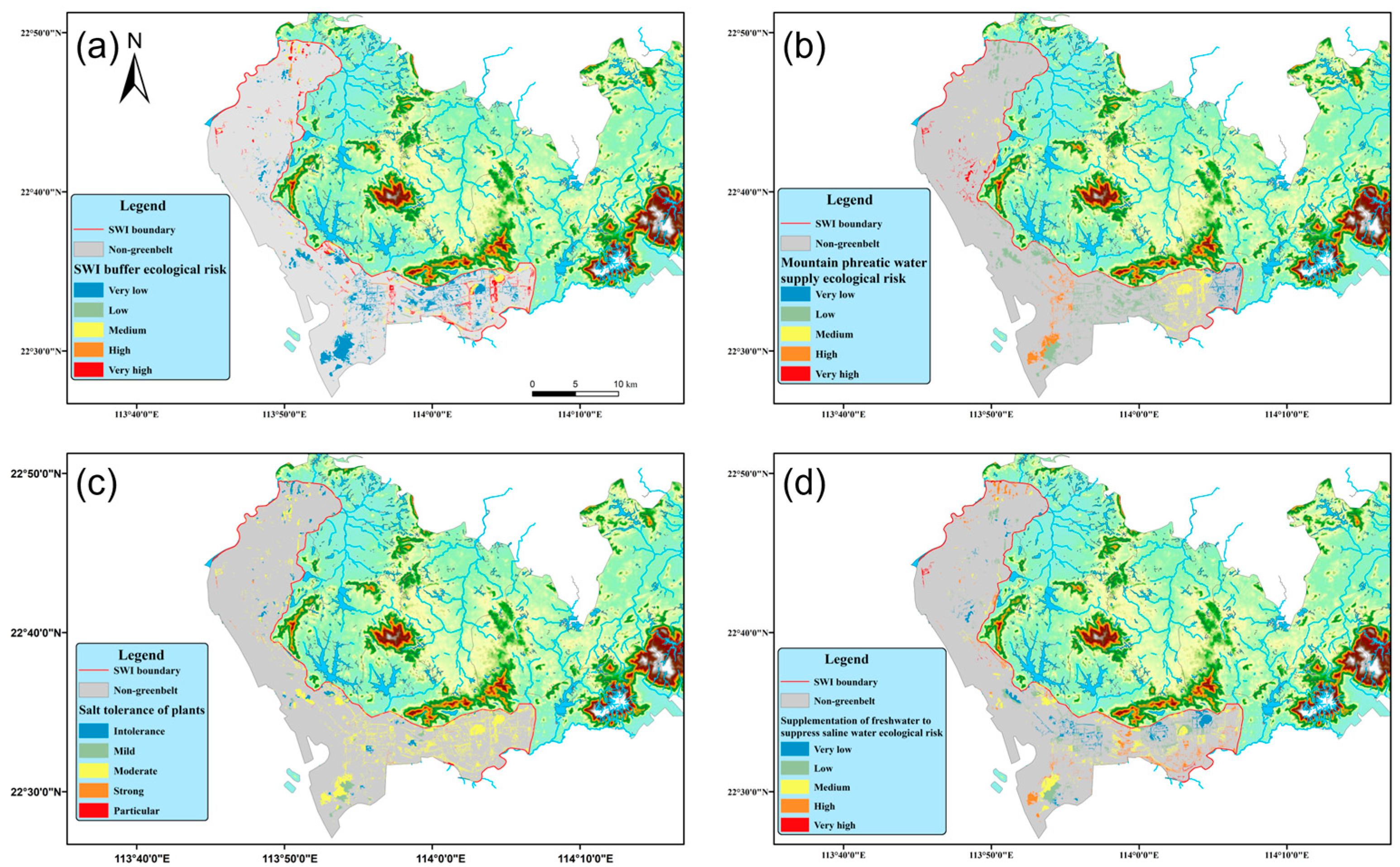
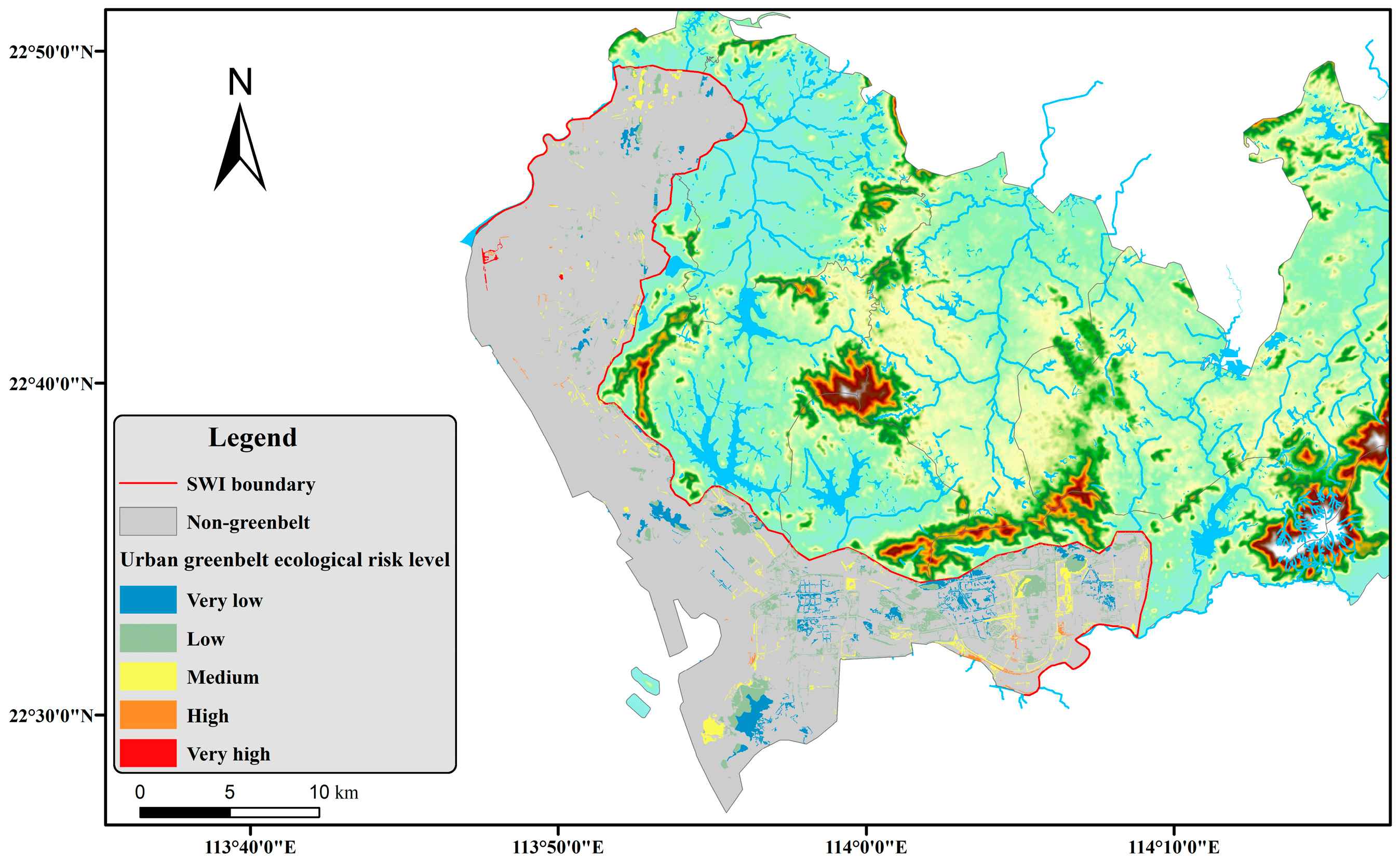
| Name | Source | Website |
|---|---|---|
| Inventory of forest resources | National Forestry and Grassland Administration | www.stgz.org.cn (accessed on 22 December 2023) |
| Hydrographic net | Open street map | www.openstreetmap.org (accessed on 3 January 2024) |
| Administrative boundary | National Catalogue Service for Geographic Information | www.webmap.cn (accessed on 16 December 2023) |
| DEM | Geospatial Data Cloud site | www.gscloud.cn (accessed on 18 December 2023) |
| Coastline | Landsat MSS/TM/ETM+/OLI | https://landsat.gsfc.nasa.gov (accessed on 21 December 2023) |
| Water Workstations | POI of AMAP | https://ditu.amap.com (accessed on 23 January 2024) |
| Research schematic material | University of Maryland Center for Environmental Science | https://ian.umces.edu (accessed on 15 January 2024) |
| Dominant Species | Salt-Tolerance Level | Code of Risk Level | |
|---|---|---|---|
| 1 | Eucalyptus robusta | Mild | 2 |
| 2 | Acacia mangium | Mild | 2 |
| 3 | Casuarina equisetifolia | Strong | 4 |
| 4 | Other soft broadleaved tree | Moderate | 3 |
| 5 | Other hard broadleaved tree | Moderate | 3 |
| 6 | Coniferous mixed forest | Particular | 5 |
| 7 | Coniferous and broadleaved mixed forest | Strong | 4 |
| 8 | Broadleaved mixed forest | Moderate | 3 |
| 9 | Litchi chinensis/Dimocarpus longan | Intolerance | 1 |
| 10 | Other woody fruit trees | Intolerance | 1 |
| 11 | Mangrove Forest | Particular | 5 |
| SF1: SWI Buffer Ecological Risk | ||||
|---|---|---|---|---|
| SWI Buffer Distance (m) | Risk Level | Distance Level | Area (km2) | |
| 1 | 0–50 | Very high | 5 | 7.644 |
| 2 | 50–100 | High | 4 | 2.169 |
| 3 | 100–300 | Medium | 3 | 6.592 |
| 4 | 300–500 | Low | 2 | 4.998 |
| 5 | >500 | Very low | 1 | 27.918 |
| SF2: Mountain phreatic water supply | ||||
| Slope length of mountain (m) | Risk level | Slope length level | ||
| 1 | 0–25 | Very high | 5 | 2.446 |
| 2 | 25–100 | High | 4 | 7.166 |
| 3 | 100–250 | Medium | 3 | 11.835 |
| 4 | 250–350 | Low | 2 | 24.985 |
| 5 | >350 | Very low | 1 | 2.888 |
| SF3: Urban greenbelt vegetation salinity-tolerance level | ||||
| Dominant Species | Salinity-tolerance level | Sensitivity level | ||
| 1 | Eucalyptus robusta | Mild | 2 | 0.599 |
| 2 | Acacia mangium | Mild | 2 | 4.058 |
| 3 | Casuarina equisetifolia | Strong | 4 | 0.261 |
| 4 | Other soft broadleaved tree | Mild | 3 | 4.097 |
| 5 | Other hard broadleaved tree | Mild | 3 | 4.397 |
| 6 | Coniferous mixed forest | Particular | 5 | 0.010 |
| 7 | Coniferous and broadleaved mixed forest | Strong | 4 | 0.207 |
| 8 | Broadleaved mixed forest | Mild | 3 | 30.953 |
| 9 | Litchi chinensis/Dimocarpus longan | Intolerance | 1 | 4.189 |
| 10 | Other woody fruit trees | Intolerance | 1 | 0.339 |
| 11 | Mangrove Forest | Particular | 5 | 0.213 |
| SF4: Supplementation of freshwater to suppress saline water Distance | ||||
| Distance from waterworks (m) | Risk level | Distance level | ||
| 1 | 0–1000 | Very low | 1 | 8.419 |
| 2 | 1000–2000 | Low | 2 | 13.231 |
| 3 | 2000–3000 | Medium | 3 | 15.519 |
| 4 | 3000–5000 | High | 4 | 11.191 |
| 5 | >5000 | Very high | 5 | 0.961 |
| Risk Level Code | Risk Level | Area (km2) | Rate (%) |
|---|---|---|---|
| 1 | Very low risk | 12.97 | 26.294 |
| 2 | Low risk | 23.44 | 47.528 |
| 3 | Medium risk | 11.30 | 22.921 |
| 4 | High risk | 1.21 | 2.454 |
| 5 | Very high risk | 0.40 | 0.803 |
Disclaimer/Publisher’s Note: The statements, opinions and data contained in all publications are solely those of the individual author(s) and contributor(s) and not of MDPI and/or the editor(s). MDPI and/or the editor(s) disclaim responsibility for any injury to people or property resulting from any ideas, methods, instructions or products referred to in the content. |
© 2024 by the authors. Licensee MDPI, Basel, Switzerland. This article is an open access article distributed under the terms and conditions of the Creative Commons Attribution (CC BY) license (https://creativecommons.org/licenses/by/4.0/).
Share and Cite
Dong, R.; Cai, Y.; Chen, X.; Wang, C.; Lian, A. Ecological Risk Assessment of Saltwater Intrusion and Urban Ecosystem Management in Shenzhen City. Land 2024, 13, 1338. https://doi.org/10.3390/land13091338
Dong R, Cai Y, Chen X, Wang C, Lian A. Ecological Risk Assessment of Saltwater Intrusion and Urban Ecosystem Management in Shenzhen City. Land. 2024; 13(9):1338. https://doi.org/10.3390/land13091338
Chicago/Turabian StyleDong, Rencai, Yue Cai, Xueye Chen, Cunjin Wang, and Anxin Lian. 2024. "Ecological Risk Assessment of Saltwater Intrusion and Urban Ecosystem Management in Shenzhen City" Land 13, no. 9: 1338. https://doi.org/10.3390/land13091338
APA StyleDong, R., Cai, Y., Chen, X., Wang, C., & Lian, A. (2024). Ecological Risk Assessment of Saltwater Intrusion and Urban Ecosystem Management in Shenzhen City. Land, 13(9), 1338. https://doi.org/10.3390/land13091338








